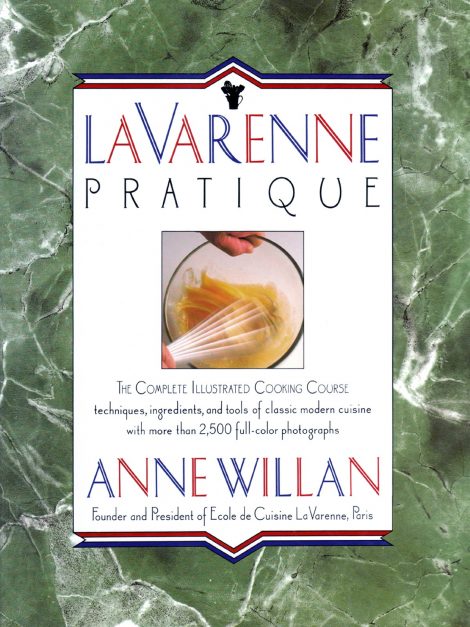The Story of La Varenne Pratique
by Anne Willan
La Varenne Pratique is the biggest book I have ever written, running to 528 pages. The core of the book includes more than 600 recipes and 1,100 color pictures of cooking techniques ranging from how to slice, dice and chop an onion to the correct way to cut a chicken into 8 pieces for coq au vin. It was put together in the late 1980s and took two years to write. I was using cutting-edge technology, an early Sony desktop machine with a vertical screen the shape of a book page. I had simply to indicate what subjects were covered on the page; the actual layouts were for the book designer, a complex mix of text, captions, headers, subheads, technique sequences and mug shots of finished recipes. My job was to supply the text and recipes for the book, plus the images for the technique sequences. Images of the finished dishes were shot separately in London.
The project began in Washington DC, where my husband was working at the time. One wall of our railroad apartment was quickly lined with shelves of cookbooks. I tracked down an editorial trainee whose mother ran a publishing company in London, so she already knew the ropes. Our chief recipe-tester was a Paris-trained chef, thus the core team was assembled. During the following months, we established the text, consisting of factual introductions and sidebars, with the full story told by hundreds and hundreds of captions. The chef tested at least a couple of hundred recipes before we were ready for the next stage.
For shooting the technique sequences, we moved to France where I was running La Varenne Cooking School in Paris and thus had access to our teaching chefs and also the trainees from all over the world who had come to learn French cooking at the source. Our chef de cuisine was Claude Vauguet, a handsome man in his forties, who was endlessly good-natured and cheerful with, most importantly, plain strong hands that fell effortlessly into the right angles for the hundreds of technique shots. The only preparation that flummoxed him was extracting the blade from cuttlefish, and for that we were able to consult our Portuguese dishwasher.
To have housed the chef and half a dozen trainees in central Paris would have been hopelessly uneconomic, so for weeks at a time we settled on our newly acquired but rustic country property an hour away in Burgundy, a seventeenth-century château. Bathrooms might be scarce but there were plenty of bedrooms and the light in the north-facing kitchen was perfect for photography. Vegetables and fruits were to hand in the walled potager garden out the back door. Trainees worked in shifts, starting at 7.00 a.m. with a visit to the local bakery for the 10 daily baguettes that fired our efforts. The day ended after we had dined on everything left over from the daily shooting schedule – the Fish and Shellfish chapter was a high point, Offal was a low. By the end, no one could face another Chocolate Truffle, though we never forgot the Rum top of fresh fruits preserved in alcohol, displayed in a vast glass tub on the mantelpiece in the kitchen. Neither fruits nor alcohol survived the final night’s shoot. Salud!
After being written in the USA and photographed in France, the bookwas first published in the UK as Reader’s Digest Complete Guide to Cookery before being re-christened La Varenne Pratique for its American debut; it went on to a dozen languages and sold more than 500,000 copies. While no longer in print, hard copies are scarce and treasured commodities, but you can purchase it as an e-book in four parts. To anyone who went to La Varenne Cooking School, and to many chefs and cooks who did not, it was called the bible. It remains one of the most comprehensive and visual books ever published on how to cook pretty much everything.


6 Comments